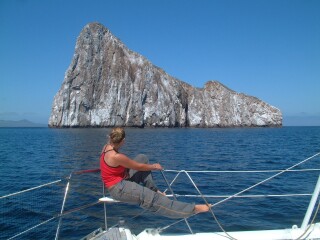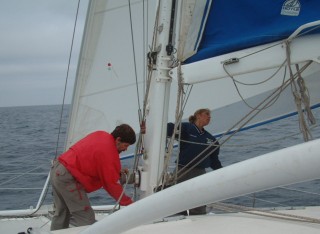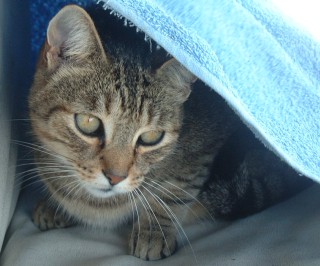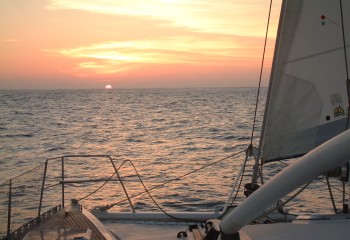
Our passage to the Galapagos curved to make the best use of the winds
Pacific Landfalls Ecuador Pages Related Pages Ecuador NewslettersGalapagos Letters Galap Flora/Fauna |
Galápagos Passage

Our passage to the Galapagos curved to make the best use of the winds
Passage Stats
Port of Departure: Manta, Ecuador. April 17, 2003
Port of Arrival: Galapagos Islands (San Cristobal). April 21, 2003
Passage Length: 530 nautical miles. 4 days and 3 hours
Average Speed: About 5.3 knots
Average Wind and Sea Conditions: About 12 knots, from the SE. Swells to 6 feet.
You can also read the newsletters we sent by email from the boat while we were on this passage. They have a certain immediacy and reflect our up to the moment thoughts and feelings.
 Approaching Kicker Rock in the Galapagos |
(Jon) The observant will notice that we did not follow a straight path in sailing from Manta to the Galapagos. This was not by accident. It's because of the prevailing winds, which come up from the south and then fan out when they reach Ecuador, spreading NE towards Columbia and NW towards the Galapagos. So the straight line course would have meant beating (an uncomfortable point of sail) out of Manta and then almost a dead run (a relatively slow point of sail) into the Galapagos. By heading a bit NW at first, we started out on a close reach (much more comfortable than a beat), which soon turned into a beam reach as the wind backed around. As we got further west, we could head more directly for the Galapagos and still keep the wind just aft of the beam, a comfortable and relatively fast point of sail.
 Shaking out a reef Note the unusual windbreakers & long pants |
An interesting aspect of this passage, all of which was within 60 miles of the
equator, was how cold it was. Long pants and windbreakers,
usually kept on board only for trips to the mountains, were necessary if we went
on deck after the sun went down. The cold Humboldt Current comes from
Antarctica, up the coast of Chile and then spreads west into the Pacific just
south of the equator. We noticed that water temperatures, usually
about 80° F (27° C) in the Caribbean, dropped down to 70° F
(21° C) by the middle of our passage.
This Humboldt
Current is also responsible for cyclones in the South Pacific. A strong
current spreads cooler water far to the west, preventing the high temperatures
cyclones need to start. If the Humboldt Current fails or is weak for some
reason (an "El Niño year") then the Pacific warms up much faster
and the cyclones can form more often and much further east.
 Birthday Breakfast - homemade cinnamon rolls! |
(Amanda age 14) Quite a nice
passage, actually. It was nice and quiet, no hectic 23.5 knots boat speed or
anything. There were several ships out with us the first night or two, but then
I got watches when I saw absolutely nothing around us but dark water, a black
sky with twinkling stars, a bright moon, and swallow-tailed gulls.
Also, I turned 14
over the passage. Probably not the way I would choose to spend my birthday, but
surely exotic. Years from now I could look back and think, "What was I
doing on my fourteenth birthday? Oh, yes, I was sailing to the Galapagos!"
Not everyone can claim that. It was a nice birthday, with cinnamon rolls for
breakfast, rotis for lunch, and I didn't have to do any of the cooking or
washing up. I did have to stand night watches, but I find I don't mind those as
much. It was amazing, sometime in the morning we sailed through a jellyfish
soup. I was asleep, but Mom was bringing up a bucket of water for washing
dishes, and it was filled with jellyfish! She looked in the water, and there
were probably twenty for every cubic foot!
 Arthur peeking out from his helm-seat tent |
(Sue) This was more like the South
Pacific Passages we'd been hearing about for years. Full moon, wind well aft of
the beam, a long gentle swell, and a pretty non-occasion passage. For me the
thrill was having Waved Albatrosses circling our boat when we were 200 miles
from land, and then, a real surprise: to have Swallow-tailed Gulls
flashing their white bellies around us at night. These gulls, which breed only
on the Galapagos Islands, are the world's only nocturnal gulls. They are
reported as far as 30 miles east of the islands, but we saw them night after
night, starting about 250 miles east of Galapagos.
The animal life on board was equally interesting:
Arthur, our 7-year-old gray tabby, passed almost
all 100 hours on the helm seat, demanding that food and water be brought up to
him. We had to lift him down to his litter box, but he was happy to jump back up
to the seat. When the seas lay pretty flat, he actually jumped down on his own
and walked out to look at the night ocean from the starboard deck. He got his
exercise by attacking the end of the jib sheet that I would dangle in front of
him and tease him with. He only slid off the helm seat once when he retreated
from the rope game too fast into his "tent" made by a towel on the
seat, and crashed to the deck!
 Sailing into another South Pacific sunset |
(Chris age 16) Well, I can't say I enjoyed it, but the passage from Manta to San Cristóbal, Galapagos was the best of our three multi-day passages so far. The seas were fairly calm, our speed was reasonable, the autopilot did almost all the hard work, and I got enough sleep. It was actually fun, in a way, to have Amanda's birthday while on passage... nobody had any other duties except the watchperson, and they didn't need to do much. I even managed to do some schoolwork by the end of the trip. Besides, getting to the Galapagos was worth it, even if I do think an airplane is a far more practical vehicle for overseas travel. Of course, our next passage is going to take about a month. We'll see how that goes.
Excerpts from Ocelot's Log:
Notes:
All distances are in Nautical miles and speeds in Knots (nautical miles/hour).
Nautical miles are about 6,000 ft, or about 15% longer than statute miles.
Wind Speed and Direction are Apparent, not True. That is, they are how our instruments perceive them while we are moving.
Date Time |
Comments | Miles |
Boat |
Wind |
Wind |
|---|---|---|---|---|---|
17 Apr 08:50 |
Engines on, leave Manta, Ecuador | 530 | |||
| 10:24 | Engines off, set 1 reef and full jib | 528 | 7 | 20 | 43 |
| noon | Shake out reef - set full sail! | 513 | 4.5 | 14 | 47 |
| 16:00 | Change clocks 1 zone west (1 hr back) | 496 | 5 | 13 | 50 |
| 18:15 | Badly headed, winds a bit fluky | 486 | 4 | 9 | 65 |
| Midnight | Scooting along nicely | 464 | 6 | 16 | 70 |
| 18 Apr 06:00 | Happy 14th Birthday, Amanda! | 427 | 6 | 14 | 75 |
| 07:45 | Jellyfish soup! | 417 | 6 | 15 | 75 |
| noon | 125 miles/day - not bad for light winds | 397 | 5+ | 15 | 75 |
| 18:30 | Tuck 1 reef in the main for the night | 362 | 6+ | 17 | 80 |
| 21:00 | Partial moon, calm seas. Several birds keeping pace with us. | 340 | 5.6 | 13 | 80 |
| 19 Apr 03:00 | 1/3 - 1/2 knot current assistance | 309 | 6-7 | 11 | 75 |
| 06:00 | Port engine on - motor to charge batteries 1/2 hour | 289 | 6 | 16 | 85 |
| 20:30 | Wind dies, start motor-sailing | 221 | 5.2 | 7 | 60 |
| 22:30 | Engine off - slightly misty, fluky wind | 210 | 6.5 | 12 | 90 |
| 20 Apr 03:00 | Happy Easter Sunday! | 189 | 5.2 | 8 | 120 |
| noon | 130 miles/day - Engines on since 10:30 | 123 | 5.7 | 4 | 120 |
| 21:00 | Dodger up, close reaching | 72 | 6.3 | 8 | 60 |
| 22:30 | Engine off, ghosting along | 63 | 6.8 | 10 | 65 |
| 21 Apr 02:10 | Port engine on - Beautiful night! | 50 | 6 | 4 | 150 |
| 06:00 | 1.3 knot current assisting | 37 | 5 | 15 | 90 |
| 07:20 | Dolphins! | 29 | 6 | ||
| noon | Engines on - Enter Wreck Bay, San Cristobal | 0 | 4 | ||
| 12:30 | Engines off - Enjoy a calm lunch and a cold beer! | 0 |
Ecuador Newsletters | Galapagos Newsletters | Galapagos Flora/Fauna
Top Level: Home | Destinations | Cruising Info | Underwater | Boat Guests | Ocelot | Sue | Jon | Amanda | Chris | Site Map | Make a Comment
|
If our information is useful, you can help by making a donation |
Copyright © 2000‑ Contact: Jon and Sue Hacking -- HackingFamily.com, svOcelot.com. All rights reserved.